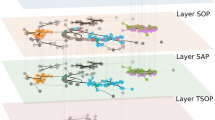Abstract
We use co-word analysis in a retrospective study of the transformation of the knowledge network in the field of polymer science from 1973 to 1976. The results of this study lead us to propose a model of change in the field. This model is based on the observation that the interaction of several networks gives rise to a sub-network that is at first central and then - and this is what the model allows us to predict — central and developed (without its precise content being predictable). Such sub-networks begin in regions of the network of central associated words where there are numerous holes or incomplete links. The model appears to be sufficiently robust statistically that it does not miss significant transformations and it suggests a way of predicting knowledge development. A comparison is made with other models of network transformation, such as the contagion model and the model of local structural equivalence.
Similar content being viewed by others
References
L. Leydesdorff,In Search of Epistemic Networks, Department of Science Dynamics, Nieuwe Achtergracht 166, 1018 WV Amsterdam, Holland.
E. Garfield,Citation Indexing, Its Theory and Application in Science. Technology and Humanities, New York, John Wiley, 1979.
B. Latour, S. Woolgar,Laboratory Life, London, Sage, 1979.
F. Bastide; Sémiotique et sciences expérimentales,Sémiotique et Bible, 38 (1985) 32–39.
J.-P. Courtial, Qualitative models, quantitative tools and network analysis,Scientometrics, 15 (1980) 527–534.
M. Callon, J.-P. Courtial, F. Laville, ‘Co-word analysis: a tool for evaluating public research programs policy-the case of polymers’, CSI Report, 62 bld. Saint-Michel, 75006 Paris.
V. Walsh, Invention and innovation in the chemical industry: Demand pull or discovery push?,Research Policy, 13 (1984) 211–234.
H. Small, E. Greenlee,A Co-Citation Study of AIDS, Research Institute of Scientific Information, Philadelphia (PA), United States.
R. Burt, Social contagion and innovation: Cohesion versus structural equivalence,American Journal of Sociology, 92 (May 1987) 1287–1335.
F. Bastide, J.-P. Courtial, M. Calllon, The use of review articles in the analysis of a research area,Scientometrics, 15 (1989) 535–558.
B. Michelet,L'Analyse des Associations, These de Doctorat en Sciences de l'Information', Université de Paris VII, INIST, Dépt. Recherche et Produits Nouveaux, CNRS, 26 rue Boyer, 75020 Paris.
A. Lelu, D. Rosenblatt, Communication au Colloque Neuro Nimes 88, Nimes, 15–17 November, 1988, “Un modele de réseau neuronal adapté a la representation et au parcours des banques de données documentaires”, INIST, CNRS, 26 rue Boyer, 75020 Paris.
J.-P. Courtial, Les réseaux de l'intelligence artificielle: la sociologie peut-elle aider a la description d'un champ scientifique?, CSI Report, 62 Boulevard Saint-Michel, 75006 Paris.
Author information
Authors and Affiliations
Rights and permissions
About this article
Cite this article
Courtial, J.P., Michelet, B. A mathematical model of development in a research field. Scientometrics 19, 127–141 (1990). https://doi.org/10.1007/BF02130469
Received:
Issue Date:
DOI: https://doi.org/10.1007/BF02130469




